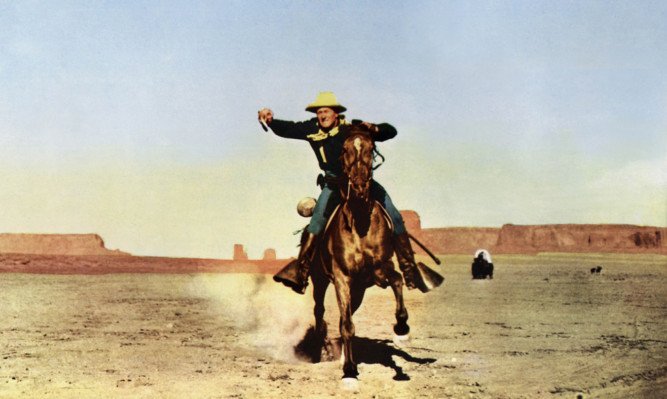
Big John was so good, he could do no wrong in any era.
They called him The Duke, but he was the kind of guy we wouldn’t mind seeing as King, President or Prime Minister.
John Wayne was on the right side, with the goodies, big, strong, tough, no-nonsense, a man who called a spade a spade and couldn’t abide the criminals getting away with things.
Born in Winterset, Iowa, on May 26, 1907, he swept through the world of cinema like one of his roles, the big man who turns up in town and sorts things out.
He’d look an evil gunslinger in the eye, never flinching, and always win in the end and for decades, he towered over the film world.
For the 1971 hit Western, Big Jake, Wayne played Jacob McCandless, an old rancher and legendary gunfighter who’s so no-nonsense, he simply calls his dog “Dog”.
He and his missus have been separated for a decade, but when the family ranch is raided by outlaws, Jake and Dog come back to put things right.
Dog gets shot, then Jake does, too, but on they battle, not the sort to back down at the first drop of blood.
Although set in 1909, it was made at a time, like now, when street violence and a weak legal system worried the nation.
Wayne was perfect as the straightforward, righteous big guy who decides to fix it all by himself.
By the end, everyone in the movie except Wayne, his missus and the limping Dog are safe to go home together!
For patriotic Americans, and later the rest of the world, the big man represented something old-fashioned but virtuous he stood up for the goodies, took a beating but came back and showed that the bad guys are always beatable.
Incredible, to think he’d first grabbed cinema crowds a full 40 years earlier, in The Big Trail you guessed it, as a good, honourable man, sorting out baddies and avenging another good guy!
It had been an incredible hit, considering it was Wayne’s first leading role. They gave The Big Trail the full lavish treatment, using the new-fangled widescreen gimmicks.
In fact, the Library of Congress still say it was such a landmark movie, filmed across large parts of the American West, that it’s a historically-important “document”.
They even called it The Most important Picture Ever Produced not bad for any star’s debut in a lead role!
Funny, of course, to think such a brick outhouse of a man was originally named Marion Robert Morrison.
If any bloke could get away with being called Marion, it was Wayne, who was an imposing lad even at school and would find few boys confident enough to laugh at him.
His father, Clyde, was son of a Civil War veteran, so they knew plenty about guns and fighting in the Morrison household.
Mum Mary was a Presbyterian, and there was Scots, Irish and English in their roots, so they were regular churchgoers, too.
So you can begin to see where John Wayne gets his values.
An unusual introduction to the world of film would follow. Still a teenager, Wayne got himself an odd job as an ice cream seller. The guy who employed him had a sideline, and shod horses for the big Hollywood studios.
Wayne’s ears pricked up at the talk of movies, and he liked the sound of learning to ride a horse, too. Keen on sports at school, he also spent a lot of time keeping fit, and when the chance of joining the Marines came up, he wrote to them.
To his horror, they turned him down for the US Naval Academy. Feeling as if he’d been slapped in the face, he instead opted for university, because he fancied a law career.
Another setback arrived, however, when he was hurt while surfing without being able to focus on the athletic side of his scholarship, he lost the money to help with his other studies, and had to leave university.
Some lads, after that double-whammy, might have gone off the rails and let their heads go down. Instead, the future John Wayne found work at a local film studio, doing odd jobs, and soon felt right at home.
With his physique and the rugged face that would become so famous, he was soon picking up a bit part here and there. You’ll search long and hard for the one film, in these early days, where he got a name check they called him Duke Morrison!
Spotted by a producer while shifting large bits of furniture around a props room, he soon found himself in that leading role in The Big Trail.
He was 23 years old and embarking on a journey that would make him the All-Time Top Money-Making Star.
It would be another 11 years before we saw John Wayne in a colour movie, and a further year before we saw him in his only bad-guy role. Reap The Wild Wind is unique, for showing Wayne as someone you wouldn’t trust with your life!
She Wore A Yellow Ribbon, The Quiet Man, The Searchers and The Man Who Shot Liberty Valance were all to come and, as the list goes on and on, you realise it would be non-stop glory for Mr Wayne.
He won an Oscar for True Grit, 39 years after his proper debut, and was nominated for another for directing The Alamo.
Amazing man that he was, in the peace-and-love 60s, he even got one for making The Green Berets, the only American movie to praise the Vietnam War.
It was another sensational milestone for an actor who could simply do no wrong, with any age group, in any era.

Enjoy the convenience of having The Sunday Post delivered as a digital ePaper straight to your smartphone, tablet or computer.
Subscribe for only £5.49 a month and enjoy all the benefits of the printed paper as a digital replica.
Subscribe